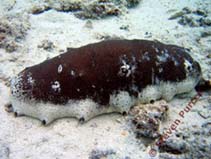Holothuria fuscogilva Cherbonnier, 1980
White teatfish| Native range | All suitable habitat | Point map | Year 2050 |

|
| This map was computer-generated and has not yet been reviewed. |
| Holothuria fuscogilva AquaMaps Data sources: GBIF OBIS |
Classification / Names Common names | Synonyms | CoL | ITIS | WoRMS
Holothuroidea | Holothuriida | Holothuriidae
Environment: milieu / climate zone / depth range / distribution range Ecology
Reef-associated; depth range 0 - 40 m (Ref. 122), usually 15 - 30 m (Ref. 98471). Tropical; 30°N - 27°S, 32°E - 138°W (Ref. 106969)
Distribution Countries | FAO areas | Ecosystems | Occurrences | Introductions
Indo-Pacific.
Length at first maturity / Size / Weight / Age
Maturity: Lm ?, range 32 - ? cm Max length : 57.0 cm TL male/unsexed; (Ref. 122); common length : 42.0 cm TL male/unsexed; (Ref. 122); max. published weight: 4.0 kg (Ref. 122)
Short description Morphology
Mean live wt. 2,400 - 4000 g; body-wall thickness: 1.2 cm. Body: sub oval, stout, firm and rigid, arched dorsally (bivium) and flattened ventrally (trivium). Bivium with characteristic large lateral papillae (teats) and often covered by sand. Bivium with small papillae as well as podia ending in a disc of around 0.045 cm diameter; podia on trivium stout, arranged irregularly, their calcareous disc around 0.06 cm in diameter. Mouth ventral, surrounded by a collar of long yellowish papillae and 20 grey, stout tentacles. Anus surrounded by 5 stout calcareous teeth. Calcareous ring with large radial pieces (slightly different from Holothuria nobilis). Cuvierian tubules absent. Color variable; bivium brown with more or less distinct whitish spots, becoming larger on sides; trivium lighter, generally whitish. Spicules in form of tables and buttons; dorsal and ventral tegument with 2 kinds of tables; one form of table having an undulated disc with 10 to 15 irregular holes, supporting a massive spire with 4 pillars, ending in a very large , spiny, perforated crown; the other form of table, more frequent in the dorsal tegument, have a larger disc, with more holes and a spire ending in a crown composed of 2 or 3 rows of stout spines and 5 or 6 spiny pillars; ventral tegument buttons simple, with 8 holes or more complicated as fenestrated ellipsoids; dorsal-tegument buttons only as fenestrated ellipsoids; ventral and dorsal podia with large plates, multiperforated; tentacles with spiny ending rods up to 0.07 cm.
Harvested in artisanal fisheries throughout the tropical Indo-Pacific, in places where its habitat occurs. Collected by skin diving or using diving gear (if not banned), making the populations vulnerable due to overexploitation. The processed product is of major commercial value and very highly demanded at present, even though the stocks have declined within the tropical Indo-Pacific. Populations do not reach densities as high as Holothuria nobilis, with medium densities around 0.001 per square meter. With deeper distribution than Holothuria nobilis (Ref. 122). Minimum depth from Ref. 98471. Generally occurs on outer barrier reefs and passes (Ref. 122), and fore reef slopes (Ref. 85218), but also known to inhabit shallow seagrass beds (Ref. 122). Also in slightly deeper waters. Common on coral slabs near reef passages or at the foot of reef slopes (Ref. 118) and lagoons over sandy bottoms (Ref. 102863). Juveniles are found to inhabit intertidal area heavily covered in algae. They are also observed in seagrass beds on a fringing reef flat (Ref. 104206). Appears to recruit to shallow seagrass beds, then migrates to deeper waters such as island gaps and moves to deeper waters of the lagoon floor as it sexually matures (Ref. 709). Deposit feeder (Ref. 833).
Life cycle and mating behavior Maturity | Reproduction | Spawning | Eggs | Fecundity | Larvae
Sexual reproduction takes place during the warm season. A species with a low potential fecundity and late sexual maturity.
Main reference
References | Coordinator | Collaborators
Conand, C. 1998. (Ref. 122)
IUCN Red List Status (Ref. 130435)
Vulnerable (VU) (A2bd); Date assessed: 15 May 2010
CITES status (Ref. 108899)
Appendix II: International trade monitored
CMS (Ref. 116361)
Not Evaluated
Threat to humans
Harmless
Human uses
Fisheries: highly commercial
FAO - Fisheries: landings | FishSource |
Tools
More information
Internet sources
BHL | BOLD Systems | CISTI | DiscoverLife | FAO(Fisheries: ; publication : search) | Fishipedia | GenBank (genome, nucleotide) | GloBI | Gomexsi | Google Books | Google Scholar | Google | PubMed | Tree of Life | Wikipedia (Go, Search) | Zoological Record
Estimates based on models
Preferred temperature
(Ref. 115969): 25.1 - 29.1, mean 28.2 (based on 862 cells).
Resilience
(Ref. 69278):
High, minimum population doubling time less than 15 months (K=0.5).
Price category
(Ref. 80766):
Unknown.



